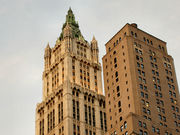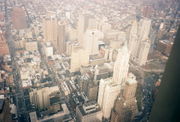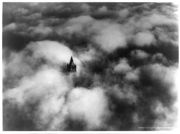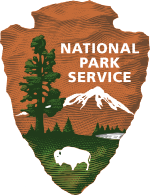Woolworth Building
| Woolworth Building | |||||||||||||||
|---|---|---|---|---|---|---|---|---|---|---|---|---|---|---|---|
|
|
|||||||||||||||
|
Woolworth Building was the world's tallest building from 1913 to 1930.[I] |
|||||||||||||||
| Record height | |||||||||||||||
| Preceded by | Metropolitan Life Insurance Company Tower | ||||||||||||||
| Surpassed by | 40 Wall Street | ||||||||||||||
| General information | |||||||||||||||
| Location | 233 Broadway, New York, NY, USA | ||||||||||||||
| Status | Complete | ||||||||||||||
| Constructed | 1910–1913 | ||||||||||||||
| Opening | April 24, 1913 | ||||||||||||||
| Height | |||||||||||||||
| Roof | 792 ft (241 m) | ||||||||||||||
| Technical details | |||||||||||||||
| Floor count | 57 | ||||||||||||||
| Cost | $13,500,000 | ||||||||||||||
| Companies involved | |||||||||||||||
| Architect(s) | Cass Gilbert | ||||||||||||||
| Structural engineer | Gunvald Aus and Kort Berle | ||||||||||||||
| Owner |
Witkoff Group |
||||||||||||||
|
|||||||||||||||
|
^ Fully habitable, self-supported, from main entrance to highest structural or architectural top; see the list of tallest buildings in the world for other listings. |
|||||||||||||||
The Woolworth Building, at 57 stories, is one of the oldest—and one of the most famous—skyscrapers in New York City. More than 95 years after its construction, it is still one of the fifty tallest buildings in the United States as well as one of the twenty tallest buildings in New York City. The building is a National Historic Landmark, having been listed in 1966.[1][2][3]
Contents |
Architecture


The Woolworth Building was constructed in neo-Gothic style by architect Cass Gilbert, who was commissioned by Frank Woolworth in 1910 to design the new corporate headquarters on Broadway, between Park Place and Barclay Street in Lower Manhattan, opposite City Hall. Originally planned to be 625 feet (190.5 m) high, in accordance with the area's zoning laws, the building was eventually elevated to 792 feet (241 m). The construction cost was $13,500,000 and Woolworth paid all of it in cash. On completion, the Woolworth building overtook the Metropolitan Life Insurance Company Tower as the world's tallest building; it opened on April 24, 1913.
With splendor and a resemblance to European Gothic cathedrals, the structure was labeled the Cathedral of Commerce by the Reverend S. Parkes Cadman during the opening ceremony. It remained the tallest building in the world until the construction of 40 Wall Street and the Chrysler Building in 1930; an observation deck on the 57th floor attracted visitors until 1945.
The building's tower, flush with the main frontage on Broadway, is raised on a block base with a narrow interior court for light. The exterior decoration was cast in limestone-colored, glazed architectural terra-cotta panels. Strongly articulated piers, carried—without interrupting cornices—right to the pyramidal cap, give the building its upward thrust. The Gothic detailing concentrated at the highly visible top is massively scaled, able to be read from the street level several hundred feet below. The ornate, cruciform lobby has a vaulted ceiling, mosaics, and sculpted caricatures that include Gilbert and Woolworth. Woolworth's private office, revetted in marble in French Empire style, is preserved.
Engineers Gunvald Aus and Kort Berle designed the steel frame, supported on massive caissons that penetrate to the bedrock. The high-speed elevators were innovative, and the building's high office-to-elevator ratio made the structure profitable. Tenants included the Irving Trust bank and Columbia Records, which housed a recording studio in the building.
Recent history
The building was owned by the Woolworth company for 85 years until 1998, when the Venator Group (formerly the F. W. Woolworth Company) sold it to the Witkoff Group for $155 million.[4] Until recently, that company kept a presence in the building through a Foot Locker store (Foot Locker is the successor to the Woolworth Company).
Prior to its 2001 destruction, the World Trade Center was often photographed in such a way that the Woolworth Building could be seen between 1 and 2 World Trade Center.
After the September 11, 2001 attacks a few blocks away, the building was without electricity, water and telephone service for a few weeks but suffered no major damage. Increased post-attack security restricted access to most of the ornate lobby, previously a tourist attraction.[5]
The structure has a long association with higher education, housing a number of Fordham University schools in the early 20th century. Today, the building houses, among other tenants, Control Group Inc. and the New York University School of Continuing and Professional Studies' Center for Global Affairs.
References in popular culture


In Laura Lee Hope's 1919 book The Bobbsey Twins in Washington is this passage:
"We'll go up in the tower and have a view," said Mr. Bobbsey, "and then we'll get lunch and go to the Bronx, where the animals are."
They entered one of the many elevators, with a number of other persons who also wanted to go to the Woolworth tower, and, in a moment, the sliding doors were closed.
"Oh!" suddenly exclaimed Nan.
And Flossie, Freddie and Bert all said the same thing, while Mrs. Bobbsey clasped her husband's arm and looked rather queer.
"What's the matter?" asked her husband.
"Why, we're going up so fast!" exclaimed the children's mother. "It makes me feel queer!"
"This is an express elevator," said Mr. Bobbsey. "There are so many floors in this tall building that if an elevator went slowly, and stopped at each one, it would take too long to get to the top. So they have some express elevators, that start at the bottom floor, and don't stop until they get to floor thirty, or some such number as that."[6]
Jeffery Deaver's 1997 book The Bone Collector, mentions the building and states that during the construction in 1913, the body of an industrialist who went missing in 1906 was found buried on the site.
The Woolworth Building has made some notable appearances in film. In the Disney film Enchanted, Narissa the dragon carries Robert up to the top of it. After killing the dragon, Robert and Giselle slide down. The building also features in the 1979 Academy Award-winning Best Picture Kramer vs. Kramer, in which Billy asks his father (played by Dustin Hoffman) its name. In the film Cloverfield, it collapses after the monster critically damages it. The building is also mentioned near the beginning of 12 Angry Men, and appears as the headquarters of Mode magazine in Ugly Betty.[7]
The Woolworth Building is also mentioned in Langston Hughes's poem "Negro":
"I've been a worker:
Under my hand the pyramids arose.
I made mortar for the Woolworth Building."
The Woolworth Building made an appearance in the video game Grand Theft Auto IV and Grand Theft Auto: Chinatown Wars as the "Woodworld Building" a.k.a. the Civic Citadel.
Inspired architecture
The Lincoln American Tower in Memphis, Tennessee, built in 1924, is a small replica of the Woolworth Building, standing one-third the height of the Woolworth's size.
See also
- Tallest buildings in New York City
- Classic Woolworth's Store in Wilmington, Delaware
- New York Daily News, Wednesday, March 11, 2009: Big Town Big Picture column, The Woolworth Building, Page 23.
References
- ↑ "Woolworth Building". National Historic Landmark summary listing. National Park Service. 2007-09-23. http://tps.cr.nps.gov/nhl/detail.cfm?ResourceId=398&ResourceType=Building.
- ↑ Patricia Heintzelman and Cecil McKithan (January 6, 1978). ""The Woolworth Building"" (PDF). National Register of Historic Places Inventory-Nomination. National Park Service. http://pdfhost.focus.nps.gov/docs/NHLS/Text/66000554.pdf.
- ↑ "The Woolworth Building--Accompanying 3 photos, exterior, from 1975." (PDF). National Register of Historic Places Inventory-Nomination. National Park Service. 1978-01-06. http://pdfhost.focus.nps.gov/docs/NHLS/Photos/66000554.pdf.
- ↑ recordonline.com - The Times Herald-Record, serving New York’s Hudson Valley and the Catskills
- ↑ Brainstorm: American Architectural Wonder: Keep Out - Chronicle.com
- ↑ Laura Lee Hope, The Bobbsey Twins in Washington, 1919.
- ↑ Soll, Lindsay (2008-10-17). "The Deep Dive: Made in NYC". Entertainment Weekly. http://www.ew.com/ew/article/0,,20233561,00.html?xid=rss-allabout-TVUglyBetty-TV+show's+shot+in+NYC. Retrieved 2010-01-21.
External links
- [1]| New York City Landmarks Preservation Commission, "Designation List 164" (1983)
- Great Buildings on-line – the Woolworth Building
- Medieval New York website – Construction details and photo images of the Woolworth Building
- New York Architecture Images – The Woolworth Building
|
||||||||||||||||||||
| Records | ||
|---|---|---|
| Preceded by Metropolitan Life Insurance Company Tower |
Tallest building in the world 1913 – 1930 |
Succeeded by 40 Wall Street |
| Tallest building in the United States 1913 – 1930 |
||
| Tallest building in New York City 1913 – 1930 |
||
|
|||||||||||||||||

